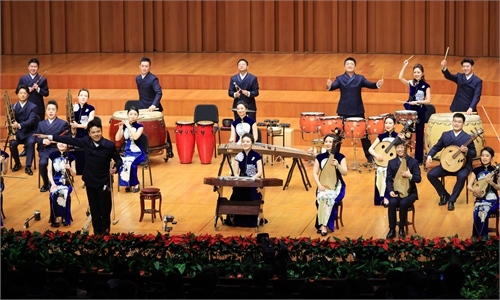ARTS / MUSIC
From bland industrial city to 'hometown' of rock’n’roll

Illustration: Liu Xiangya/Global Times
"Kill the one from Shijiazhuang" is a kind of super-phrase for many young music lovers in China, the title of a song by a famous rock band.
The song brought Shijiazhuang, capital of North China's Hebei Province, a city with a significant status in Chinese rock and pop music scene, back into the spotlight. The city's name Shijiazhuang, which wittily translates to "rock hometown," was recently used as a play on words by the city authorities to describe the city's music scene as the "hometown of rock music," a connection that young people in China adore, just as they passionately embrace anything that exudes interest, vitality and creativity.
Shijiazhuang and its connection to Chinese rock music can be traced back to the birth of two magazines that are considered the guides to rock music for a majority of Chinese music lovers. The first, Tong Su Ge Qu (Popular Songs), was established in 1984, and the second, Wo Ai Yao Gun Yue (I Love Rock Music), was launched in 1999.
Both magazines played a crucial role in popularizing Chinese rock music. Located nearly 300 kilometers southwest of Beijing, Shijiazhuang enjoys a unique geographical advantage as a rock music haven, often referred to as the "backyard of Beijing rock music." Many of the capital's most famous rockers started their journey in the industrial city.
The truth of the matter is, there is simply no way to kill any guy from Shijiazhuang.
On the morning of July 16, rockers made a surprise appearance at the Beiguo Shopping Mall Station in Shijiazhuang's subway. Boarding a Line 1 train, they started performing classic hits "Xihuan Ni" (I Like You) and "Huozhe" (Alive). Gradually, passengers began humming along with the musicians, and the subway car became enveloped in the melodies, infusing the Sunday morning with vibrant energy.
This remarkable rock'n'roll scene represented the launch of a significant plan. This once-prominent heavy industry center in North China has ingeniously seized upon the cultural keyword "rock," embarking on a creative journey to establish itself as the hometown of rock, announcing a series of concerts and pop-up performances in public places and on public transportation. The series of performances is set to last through October.
The creation of this "Rock Hometown" initiative not only provides a playground for the hormones, talents, and fortunes of young people but, more importantly, it conveys a message: the Chinese city is creatively riding on the cultural interests and aesthetics of its young population to ignite an urban economic revival. Every outstanding new creation, the rise of a new band, or the resurgence of an old song has the potential to trigger new economic miracles, especially when the music is uplifting and energetic.
It is worth noting that this approach represents a significant evolution from the practices of the previous decades, when "culture provides the stage, and the economy performs" seemed to prioritize culture as a gimmick for investment promotion activities, with culture playing a supporting or introductory role.
The latest Shijiazhuang approach is more akin to allowing culture to play according to its own nature, and this very nature itself brings tremendous vitality to society. It is within this vitality that countless economic miracles are born.
A recent perfect case in point is the overnight explosion of popularity in the barbecue scene in Zibo, East China's Shandong Province. The high praise from young people on social media for the city's simple and honest folk customs converged into a strong identification with its local culinary industry.
When a large number of tourists flocked to Zibo, the local government astutely seized the opportunity, presenting a harmonious picture of efficient governance and amiable cooperation within the service sector.
In an instant, this relatively unknown industrial city transformed into a significant economic growth driver. Clearly, this culture-driven practice of emotional communication far surpasses any elaborate commercial packaging and promotion in its ability to stimulate the economy.
Shijiazhuang is betting big on its connections with rock history to attract people who would not normally be attracted to a northern industrial city. It will bring not only a surge in consumption but, more importantly, a sense of optimism and confidence. That is the most crucial element at play here.



